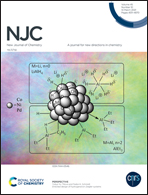Boron-based Be2B5+/0/− alloy clusters: inverse sandwiches with pentagonal boron ring and reduction-induced structural transformation to molecular wheel structure†
Abstract
Elemental boron clusters feature double chain structures and hypercoordinate molecular wheels, owing to their electron-deficiency. We report on the structural, electronic, and bonding properties of a series of binary Be2B5q (q = +1, 0, −1) clusters using quantum chemical calculations. The cationic cluster assumes an inverse sandwich geometry, being composed of a pentagonal B5 ring and two capping Be atoms. It can be formally described as a charge-transfer [Be]2+[B5]3−[Be]2+ complex, with a minor covalent component between the B5 ring and two Be atoms. The [B5]3− unit is shown to be chemically robust with double 6π/2σ aromaticity, suggesting the potential to be developed as a new inorganic ligand. Its 6π framework mimics that of the cyclopentadienyl anion (C5H5−), although a π sextet is not possible in bare boron clusters of similar sizes. The neutral inverse sandwich is similar to the cation, except for a distortion to lower symmetry. The anionic cluster has a molecular wheel structure, governed by double 2π/6σ aromaticity. Thus, sequential reduction in the series leads to a structural transformation from inverse sandwich to molecular wheel, further demonstrating the robustness of the [B5]3− unit with exactly 18 electrons. Although the cationic inverse sandwich and anionic molecular wheel (with 20 electrons) differ by two electrons, they are the same in terms of total number of delocalized π/σ electrons: 6π/2σ versus 2π/6σ. The bicapping Be atoms in an inverse sandwich interact with boron rings in peculiar ways, thus effectively stabilizing the delocalized π framework with respect to the σ one. Double π/σ aromaticity appears to be a crucial bonding concept in boron-based alloy clusters.



 Please wait while we load your content...
Please wait while we load your content...